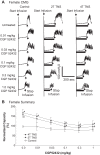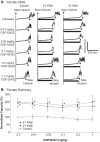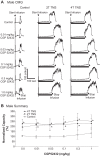Sex difference in the contribution of GABAB receptors to tibial neuromodulation of bladder overactivity in cats
- PMID: 27974317
- PMCID: PMC5402006
- DOI: 10.1152/ajpregu.00401.2016
Sex difference in the contribution of GABAB receptors to tibial neuromodulation of bladder overactivity in cats
Abstract
This study investigated the role of γ-aminobutyric acid subtype B (GABAB) receptors in tibial and pudendal neuromodulation of bladder overactivity induced by intravesical administration of dilute (0.5%) acetic acid (AA) in α-chloralose-anesthetized cats. To inhibit bladder overactivity, tibial or pudendal nerve stimulation (TNS or PNS) was applied at 5 Hz and two or four times threshold (T) intensity for inducing toe or anal sphincter twitch. TNS at 2T or 4T intensity significantly (P < 0.05) increased the bladder capacity to 173.8 ± 16.2 or 198.5 ± 24.1%, respectively, of control capacity. Meanwhile, PNS at 2T or 4T intensity significantly (P < 0.05) increased the bladder capacity to 217 ± 18.8 and 221.3 ± 22.3% of control capacity, respectively. CGP52432 (a GABAB receptor antagonist) at intravenous dosages of 0.1-1 mg/kg completely removed the TNS inhibition in female cats but had no effect in male cats. CGP52432 administered intravenously also had no effect on control bladder capacity or the pudendal inhibition of bladder overactivity. These results reveal a sex difference in the role of GABAB receptors in tibial neuromodulation of bladder overactivity in cats and that GABAB receptors are not involved in either pudendal neuromodulation or irritation-induced bladder overactivity.
Keywords: GABA; bladder; cat; neuromodulation.
Copyright © 2017 the American Physiological Society.
Figures








Similar articles
-
Role of cannabinoid receptor type 1 in tibial and pudendal neuromodulation of bladder overactivity in cats.Am J Physiol Renal Physiol. 2017 Mar 1;312(3):F482-F488. doi: 10.1152/ajprenal.00586.2016. Epub 2016 Dec 7. Am J Physiol Renal Physiol. 2017. PMID: 27927655 Free PMC article.
-
Glutamatergic Mechanisms Involved in Bladder Overactivity and Pudendal Neuromodulation in Cats.J Pharmacol Exp Ther. 2017 Jul;362(1):53-58. doi: 10.1124/jpet.117.240895. Epub 2017 Apr 20. J Pharmacol Exp Ther. 2017. PMID: 28428223 Free PMC article.
-
Contribution of opioid and metabotropic glutamate receptor mechanisms to inhibition of bladder overactivity by tibial nerve stimulation.Am J Physiol Regul Integr Comp Physiol. 2013 Jul 15;305(2):R126-33. doi: 10.1152/ajpregu.00572.2012. Epub 2013 Apr 10. Am J Physiol Regul Integr Comp Physiol. 2013. PMID: 23576608 Free PMC article.
-
Where Are We Headed with Neuromodulation for Overactive Bladder?Curr Urol Rep. 2017 Aug;18(8):59. doi: 10.1007/s11934-017-0711-x. Curr Urol Rep. 2017. PMID: 28656519 Review.
-
Mechanism of Action of Tibial Nerve Stimulation in the Treatment of Lower Urinary Tract Dysfunction.Neuromodulation. 2024 Feb;27(2):256-266. doi: 10.1016/j.neurom.2023.03.017. Epub 2023 May 12. Neuromodulation. 2024. PMID: 37178068 Review.
Cited by
-
Spinal interneuronal mechanisms underlying pudendal and tibial neuromodulation of bladder function in cats.Exp Neurol. 2018 Oct;308:100-110. doi: 10.1016/j.expneurol.2018.06.015. Epub 2018 Jul 7. Exp Neurol. 2018. PMID: 30017972 Free PMC article.
-
Spinal mechanisms of pudendal nerve stimulation-induced inhibition of bladder hypersensitivity in rats.Neurosci Lett. 2018 Nov 1;686:181-185. doi: 10.1016/j.neulet.2018.08.041. Epub 2018 Sep 12. Neurosci Lett. 2018. PMID: 30218768 Free PMC article.
-
The mechanism of action of neuromodulation in the treatment of overactive bladder.Nat Rev Urol. 2025 Jul;22(7):414-426. doi: 10.1038/s41585-024-00967-8. Epub 2024 Dec 9. Nat Rev Urol. 2025. PMID: 39653756 Review.
-
Biomarkers in the diagnosis and symptom assessment of patients with bladder pain syndrome: a systematic review.Int Urogynecol J. 2019 Nov;30(11):1785-1794. doi: 10.1007/s00192-019-04075-9. Epub 2019 Aug 13. Int Urogynecol J. 2019. PMID: 31410520
References
-
- Abrams P, Cardozo L, Fall M, Griffiths D, Rosier P, Ulmsten U, Van Kerrebroeck P, Victor A, Wein A; Standardisation Sub-Committee of the International Continence Society . The standardisation of terminology in lower urinary tract function: report from the standardisation sub-committee of the International Continence Society. Urology 61: 37–49, 2003. doi:10.1016/S0090-4295(02)02243-4. - DOI - PubMed
-
- Araki I. Inhibitory postsynaptic currents and the effects of GABA on visually identified sacral parasympathetic preganglionic neurons in neonatal rats. J Neurophysiol 72: 2903–2910, 1994. - PubMed
-
- Coyne KS, Sexton CC, Irwin DE, Kopp ZS, Kelleher CJ, Milsom I. The impact of overactive bladder, incontinence and other lower urinary tract symptoms on quality of life, work productivity, sexuality and emotional well-being in men and women: results from the EPIC study. BJU Int 101: 1388–1395, 2008. doi:10.1111/j.1464-410X.2008.07601.x. - DOI - PubMed
Publication types
MeSH terms
Substances
Grants and funding
LinkOut - more resources
Full Text Sources
Other Literature Sources
Medical
Miscellaneous

